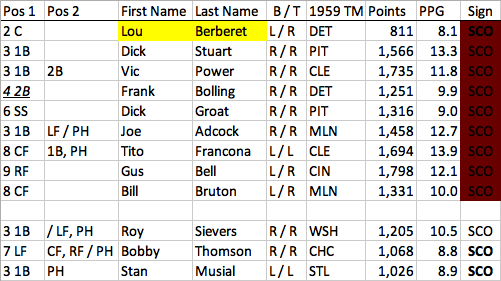1959 Fantasy Astrology Recap
View the 1959 FABL Lineups Here!
In my recap of the 1960 Fantasy Astrology Baseball League season, I remarked on my anxiety of populating 12 FABL teams from a pool of just 16 MLB teams. Those fears proved to be moot, given that all signs were able to field (mostly) complete rosters. What’s more, positional eligibility issues didn’t lead to any problems with the final standings, as all four division winners would have finished on top regardless of whether I cheated players into spots where they didn’t actually qualify. But as we burst into a new decade, we are immediately confronted with some drastic consequences of a league that’s half the size of today’s.
While Leo and Taurus lead the Fire and Air divisions, regardless of positional eligibility, the other two divisions are hotly contested. Given my loose interpretation of eligibility rules, Aquarius would finish second overall in fantasy points, and squeak ahead of Libra for the Air Division lead. Similarly, allowing some key Scorpio players to slot in at unfamiliar positions would put the Stingers on top in a weak Water Division. However, with all positional rules followed, Scorpio would drop all the way from fifth place to ninth, allowing eighth-place Pisces to overtake them. And lest you think the two uncontested divisions are safe, consider that following positional eligibility rules would cause Taurus to leapfrog both Aquarius and Leo, making them the top-scoring sign in the league.
I’ll start by very briefly going through the leaders, since we’ve seen a lot of these two signs in the past few years, and also because it’s more interesting to talk about the divisional battles. The 1959 Lions had a lineup built around two Ohio-based star sluggers: Vada Pinson (2,529 / 16.4) of Cincinnati and Rocky Colavito (2,215 / 14.4) of Cleveland. Likewise in the rotation, Leo had a great 1-2 punch in Don Drysdale (2,471 / 56.2) and Hoyt Wilhelm (2,267 / 70.8), the latter in his only season where he had more starts than relief appearances. Taurus was a little more top-heavy, but they did have both of the top award winners in Negative Polarity: MVP Willie Mays (2,812 / 18.6) and CYA winner Warren Spahn (2,494 / 62.4).
The much-maligned Aquarius team slugged their way to the top of the Air Division with the tandem of Positive Pole MVP Henry Aaron (2,968 / 19.3) and third-place finisher Ernie Banks (2,665 / 17.2 – Pinson finished fourth). The Water Bearers pitching staff lacked a true shutdown ace, but their top scorer - Jerry Walker (1,680 / 56.0) of Baltimore – was also the Polarity’s top rookie. Their main competition was Libra, who rode great offensive seasons from Eddie Mathews (2,692 / 18.2) and Mickey Mantle (2,246 / 15.6), the #2 and #5 finishers among PP batters in fantasy points. Scales ace Jim Bunning (2,138 / 53.5) was the #5 PP starting pitcher, while Cubs closer Bill Henry (1,785 / 27.5) was the top reliever in the league (even though saves weren’t counted as an official stat until almost a decade later).
Scorpio didn’t have a particularly standout lineup, with their top scorer being Reds outfielder Gus Bell (1,798 / 12.1), father of Buddy, and grandfather of David, who is, coincidentally, Cincinnati’s current manager. The only player above 2,000 points was starter Lew Burdette (2,035 / 49.6), but they benefitted from essentially having six starters: top primary relief pitcher Jim Perry (1,527 / 34.7) started 13 of his 44 appearances. He also ended the year as the NP’s #2 rookie, behind Cancer Crab Bob Allison (1,972 / 13.1), and the #3 primary reliever. The leader in that category, Roy Face (1,572 / 27.6), pitched for Pisces, who would have overtaken Scorpio considering positional eligibility rules. That fact is even more pathetic for the Water Division, considering Pisces had only two pitchers with more than 10 starts on the year. However, one of them was Vern Law (2,385 / 70.1), the #3 NP pitcher, to go along with Jackie Jensen (2,365 / 16.0), the #3 NP batter.
The only award we haven’t covered so far is the Positive Polarity Cy Young, which would go to Sagittarian Sam Jones (2,687 / 53.7), who was acquired by the Giants prior to the season. To put this season in perspective, Jones made his Major League debut in 1947 pitching for the Cleveland Buckeyes of the Negro American League. Of course, the Negro Leagues were not considered Major Leagues at the time, but the lack of recognition is the least distressing part of the segregation going on in the US in that historical period. The implications of this type of systemic racism makes it less and less rewarding to focus on MLB the further back in time this project goes… but once we hit the late 1940’s, I’ll be able to add Negro League stats into my database!




